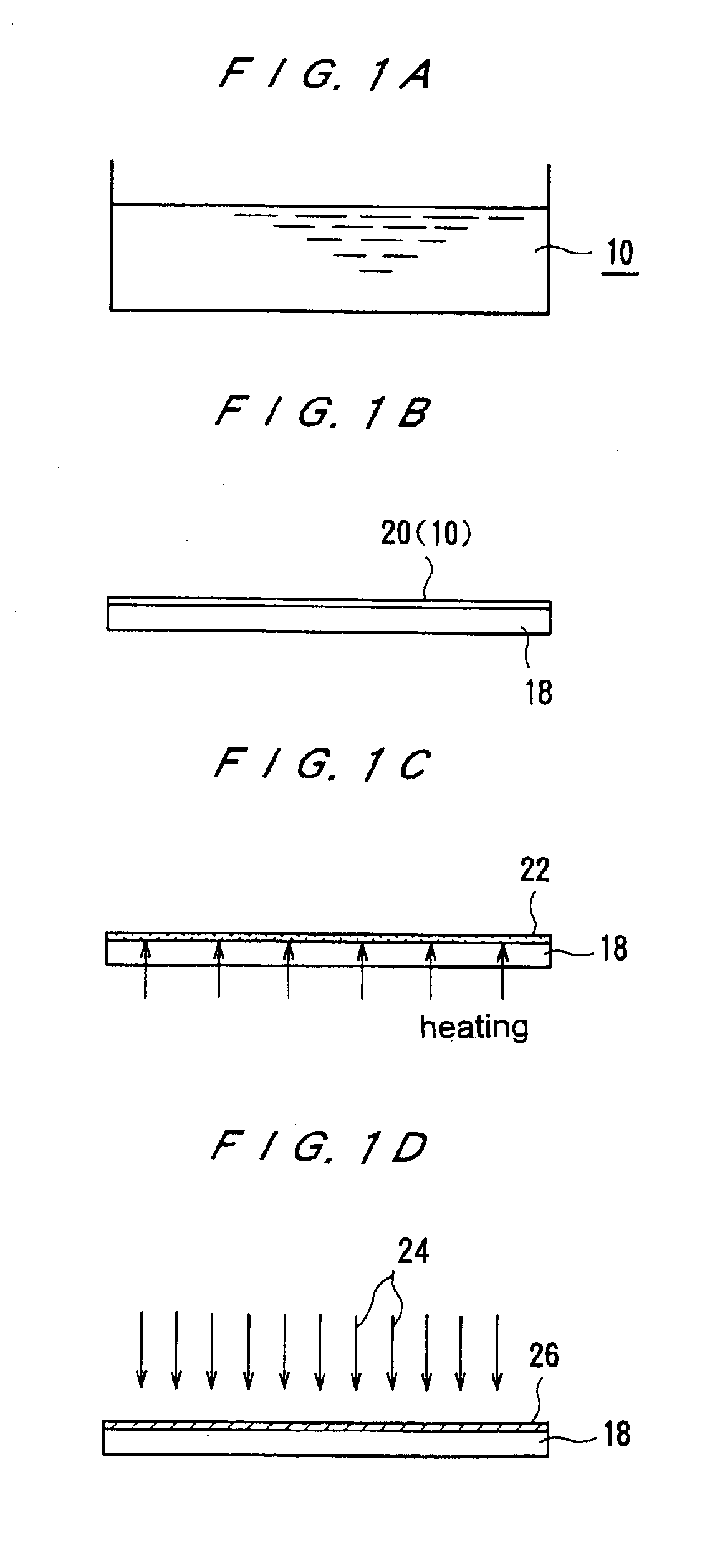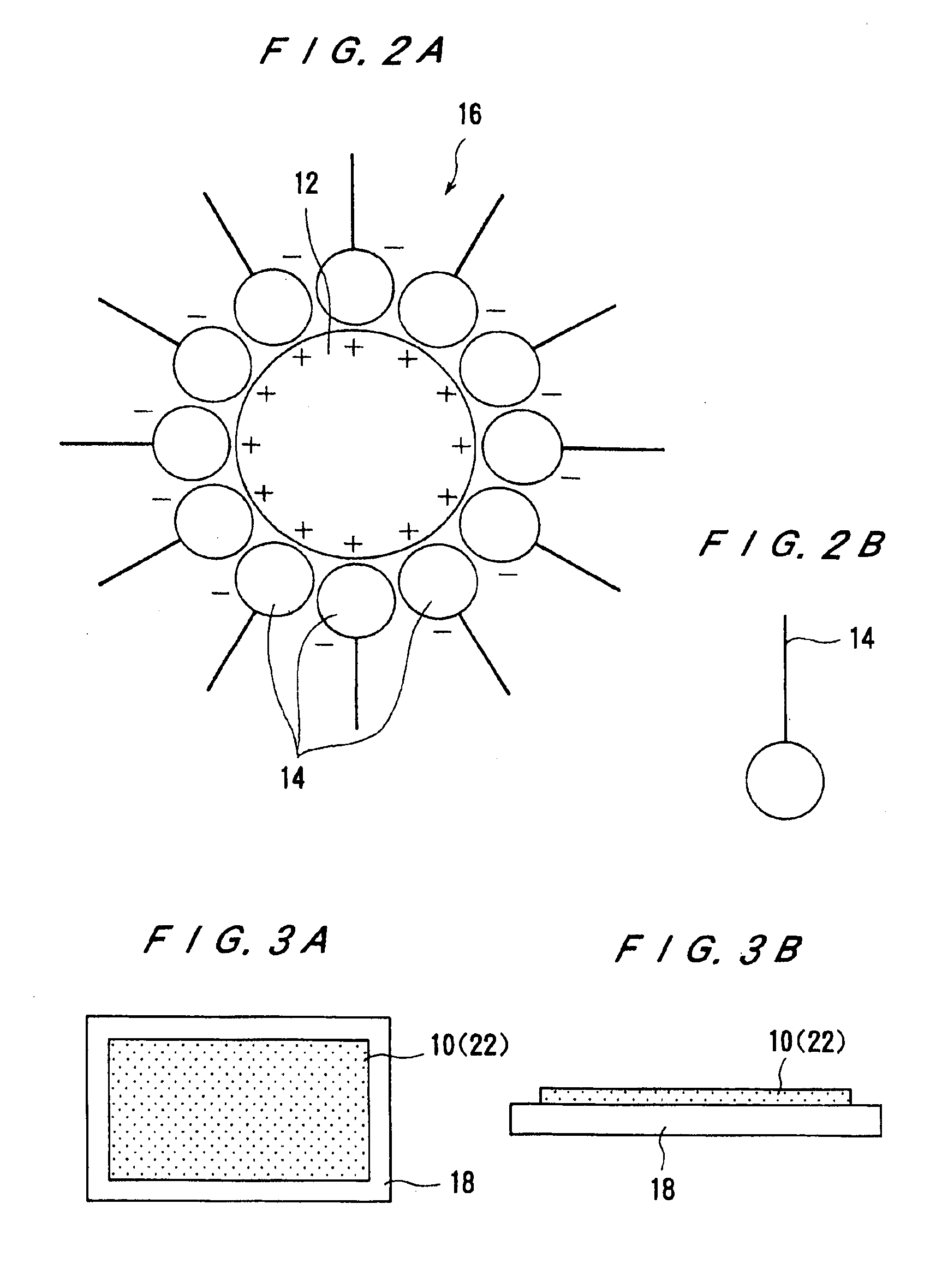Method and apparatus for forming thin film of metal
a thin metal film and metal technology, applied in the direction of solid-state diffusion coating, liquid/solution decomposition chemical coating, conductive pattern formation, etc., can solve the problem of not being able to actually form patterns on metals that are difficult to etch, need an increased number of steps, and increase the number of steps. , to achieve the effect of increasing product quality and increasing yield
- Summary
- Abstract
- Description
- Claims
- Application Information
AI Technical Summary
Benefits of technology
Problems solved by technology
Method used
Image
Examples
example 1
[0103]Oleic acid was used as an organic anionic substance, and silver acetate was used as a metal source. 0.5 L of a naphthene-based high boiling solvent having a distilling point of 250° C. was placed into an eggplant-shaped flask having a volume of 1 L, and 10 g of silver acetate and 20 g of oleic acid were added to the solvent. The mixture was then heated at 240° C. for 3 hours. As the mixture is heated, its color changed from colorless to light brown to purple. After the mixture was heated, acetone was added to the mixture, and the mixture was then refined by way of precipitation.
[0104]The modified powder was observed by a transmissive electron microscope. The observation indicated that the powder was composed of ultrafine metal particles having a diameter of about 10 nm. An X-ray powder diffraction process conducted on the powder confirmed cores of metal silver.
[0105]The powder composed of ultrafine particles (ultrafine composite metal particles) was then dispersed in toluene a...
example 2
[0106]Stearic acid was used as an organic anionic substance, and copper carbonate was used as a metal source. 0.5 L of a paraffin-based high boiling solvent having a distilling point of 250° C. was placed into an eggplant-shaped flask having a volume of 1 L, and 10 g of copper carbonate and 40 g of stearic acid were added to the solvent. The mixture was then heated at 300° C. for 3 hours. As the mixture was heated, its color changed from light green to dark green to brown. After the mixture was heated, methanol was added to the mixture, and the mixture was then refined by way of precipitation. The powder composed of ultrafine particles (ultrafine composite metal particles) was then applied to a substrate in the same manner as with Example 1. As a result, good copper interconnects were formed.
example 3
[0107]Sodium dodecylbenzenesulfonate was used as an organic anionic substance, and chloroauric acid was used as a metal source. 0.5 L of xylene (isomer mixture) was placed into an eggplant-shaped flask having a volume of 1 L, and 5 of chloroauric acid and 20 g of sodium dodecylbenzenesulfonate were added to the solvent. The mixture was then heated at 150° C. for 3 hours. As the mixture was heated, its color changed from yellow to light brown to red. After the mixture was heated, acetone was added to the mixture, and the mixture was then refined by way of precipitation.
[0108]The powder composed of ultrafine particles (ultrafine composite metal particles) was then applied to a substrate in the same manner as with Example 1. As a result, good gold interconnects were formed.
PUM
| Property | Measurement | Unit |
|---|---|---|
| diameter | aaaaa | aaaaa |
| diameter | aaaaa | aaaaa |
| diameter | aaaaa | aaaaa |
Abstract
Description
Claims
Application Information
 Login to View More
Login to View More - R&D
- Intellectual Property
- Life Sciences
- Materials
- Tech Scout
- Unparalleled Data Quality
- Higher Quality Content
- 60% Fewer Hallucinations
Browse by: Latest US Patents, China's latest patents, Technical Efficacy Thesaurus, Application Domain, Technology Topic, Popular Technical Reports.
© 2025 PatSnap. All rights reserved.Legal|Privacy policy|Modern Slavery Act Transparency Statement|Sitemap|About US| Contact US: help@patsnap.com



